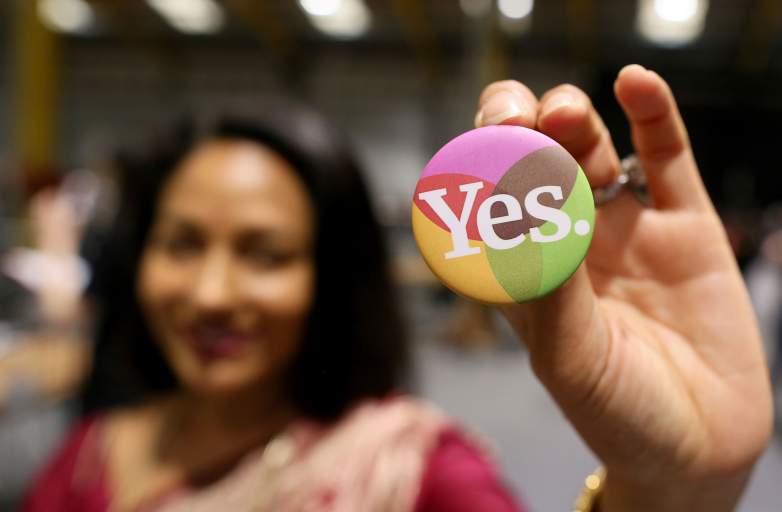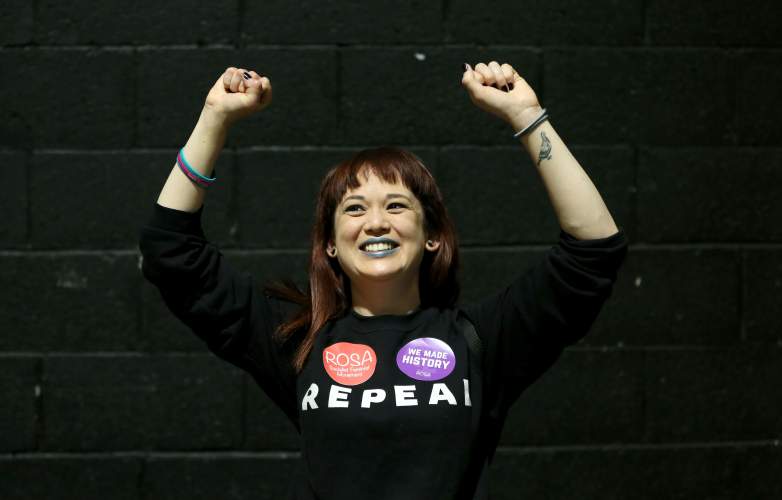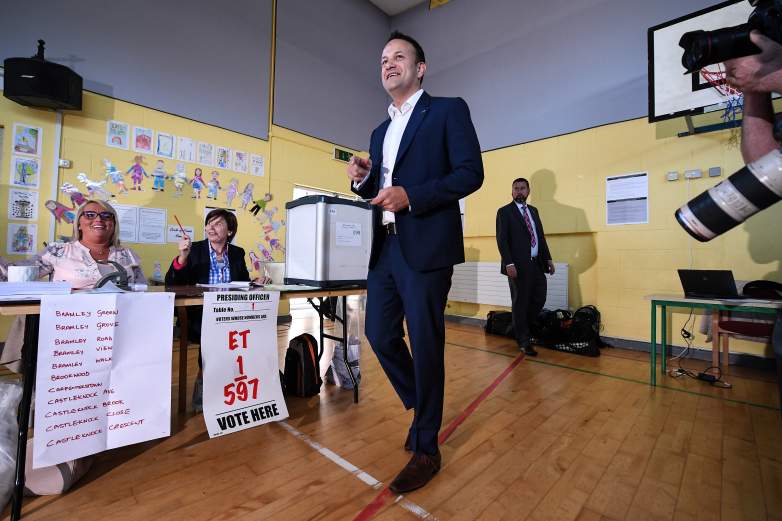
Getty Ireland has voted by a landslide to lift the ban on abortion that had been enshrined in its constitution for three decades.
Ireland is about to make history by repealing some of the world’s most restrictive abortion legal guidelines after two major exit polls predicted voters in the traditionally Catholic country have opted to change the Constitution.
The poll released by Ireland’s national broadcaster RTE predicted that nearly 70% voted in favor of repealing the Eighth Amendment to Ireland’s Constitution. The RTE exit poll shows 69.4% voting “yes” and 30.6% “no.”
The Eighth Amendment, which was added to the constitution following a referendum in 1983, places the rights of the fetus and the rights of its mother on equal footing, effectively banning abortion barring a “real and substantial risk” to the mother’s life.
An electorate of more than 3.2 million were eligible to cast their ballots Friday, including thousands of Irish people living overseas who had made the journey home to vote, according to CNN.
Here’s what you need to know:
1. The Eighth Amendment Gives the Fetus the Same Right to Life as the Mother, Essentially Banning Abortion Almost Completely in Ireland

GettyAn information poster for voters is displayed at the Marlborough Street National School polling station in Dublin, Ireland on May 25, 2018, during the Irish referendum on liberalising the abortion law. – People in Ireland on Friday voted in a landmark referendum on whether the traditionally Catholic country should liberalise some of the strictest abortion laws in Europe. (Photo by BARRY CRONIN / AFP) (Photo credit should read BARRY CRONIN/AFP/Getty Images)
The Eight Amendment to the Irish Constitution acknowledges “the right to life of the unborn, with due regard to the equal right to life of the mother.” Aside from a “risk of loss of life of pregnant woman,” the amendment prevents any relaxation of the country’s near-total ban on abortion. Abortion is not permitted even in cases of rape, incest or fetal abnormalities.
Deliberately terminating a pregnancy has been a criminal offense in Ireland since 1861; however, the modern debate started back in the 1970’s, a time when regulations about abortion and birth control were changing in many places.
The U.K. had legalized abortion up to 28 weeks in 1967, shortly before the historic 1973 ruling by the U.S. Supreme Court in Roe v. Wade. The ruling essentially legalized abortion in the United States, which alarmed conservative politicians and the Catholic Church. They launched an active campaign to introduce a constitutional amendment to that purpose to assure the Irish ban on abortion would stay in place, which culminated in a referendum in 1983. According to TIME, about 67% voted in favor of the eighth amendment at the time — the same amendment up for repeal this week.
“The State acknowledges the right to life of the unborn,” the amendment reads, “and, with due regard to the equal right to life of the mother, guarantees in its laws to respect, and, as far as practicable, by its laws to defend and vindicate that right.”
2. The Infamous “X Case” Was a Tipping Factor in Abortion Rights, Ruling that Suicide as a Threat to the Mothers Life, Allowing Abortions in Some Serious Cases

A Yes voter poses with a badge as votes are counted in the Irish abortion referendum, at the RDS Conference centre in Dublin on May 26, 2018. – Ireland looks set to “make history” by liberalising some of the strictest abortion laws in Europe, Prime Minister Leo Varadkar said as votes in the hard-fought referendum were counted on May 26, 2018. (Photo by Paul FAITH / AFP) (Photo credit should read PAUL FAITH/AFP/Getty Images)
Following the implementation of the Eighth Amendment, some groups continued to protest the ban, but it wasn’t until 1992 that the abortion issue was seriously revisited during Ireland’s historic “X Case.”
A 14-year-old girl, known in the media only as “X,” was raped, found out she was pregnant, and decided to travel to the U.K. to have an abortion. Her family told police about the plan, to find out if they could do a DNA test after the abortion to prove the paternity of the girl’s rapist.
Instead, the young teenager was blocked from traveling abroad due to an injunction issued by the Attorney General. The girl became suicidal, which brought the case to Ireland’s Supreme Court. After determining that there was a real “risk to the life of the mother,” the Supreme Court dropped the injunction. Since then, suicide has been included when determining risk to the health and well-being of the mother.
According to the Life Institute, “As a result of that decision, technically any pregnant woman is entitled to have an abortion (even up to 9 months – there is no time limit to the Supreme Court judgement) if she claims to be suicidal as a result of the pregnancy – an extremely difficult condition to disprove – and furthermore, she may technically have the abortion carried out in Ireland if a doctor agreed to perform it.”
Since 1992, several attempts to remove suicide as grounds for abortion – including a referendum in 2002 – have failed, according to the TIME. But the Supreme Court’s ruling did not make it into legislation for another 20 years after the case ended.
However, the X case did inevitably lead to some change. Two referendums in November 1992 made it legal to travel abroad to seek abortions and to share information about foreign abortion services within Ireland, according to TIME. Some 170,000 women are estimated to have traveled out of Ireland for an abortion since 1980.
3. A Behavioral Survey Showed that Most Voters Made up Their Minds to Repeal Abortion Laws Years Ago, Before the Referendum Proposition

Yes voter Keishia Taylor poses as votes are counted in the Irish abortion referendum, at the RDS Conference centre in Dublin on May 26, 2018. – Ireland looks set to “make history” by liberalising some of the strictest abortion laws in Europe, Prime Minister Leo Varadkar said as votes in the hard-fought referendum were counted on May 26, 2018. (Photo by Paul FAITH / AFP) (Photo credit should read PAUL FAITH/AFP/Getty Images)
Colm O’Gorman, the head of Amnesty International in Ireland, which campaigned for the yes vote, said that although expectations for Saturday’s count would be close, attitude surveys conducted in 2015 “had shown deep changes in thinking on abortion.”
The RTE poll predicts a vote of 69.4% in favor of reform, with 30.6% against. According to the poll, more than 75% said they had not changed their mind on abortion in the past five years, suggesting their support for reform had significantly predated support for the referendum that was announced two months ago.
A staggering 82% of voters said they had not changed their mind on how they were going to vote during the campaign.
“More than three-quarters said they were influenced by personal stories they heard in the media or by people they knew,” according to the Guardian.
One of the main anti-abortion campaigns has already admitted defeat.
“The unborn child no longer has a right to life recognized by the Irish state,” said John McGuirk, from Save the 8th.
However, according to the BBC, McGuirk vowed that “No” campaigners would continue to protest, “if and when abortion clinics are opened in Ireland”.
“Every time an unborn child has his or her life ended in Ireland, we will oppose that, and make our voices known,” he added.
4. Despite a Challenging Uphill Battle for the “Yes Vote,” Activists Have been Making Strides in Abortion Rights Over the Last Three Decades; However, the “No Vote” Group Has Garnered International Support from Pro-Lifers Around the World

GettyDUBLIN, IRELAND – MAY 25: The Taoiseach, Leo Varadkar, casts his vote in Irelands abortion referendum at Scoil Thomas Lodge polling station on May 25, 2018 in Dublin, Ireland. Polling stations are open across the Ireland where voters will decide whether or not to abolish the 8th amendment which makes abortions illegal in the country, unless a mother’s life is in danger. (Photo by Jeff J Mitchell/Getty Images)
5. The Death of Savita Praveen Halappanavar in 2012 Brought Global Media Attention to the Country’s Strict Abortion Laws

GettyFloral tributes are laid at a mural to Savita Halappanavar, a 31-year-old Indian dentist, who died in 2012 due to the complications of a septic miscarriage at 17 weeks’ gestation, in Camden Street, Dublin, Ireland on May 26, 2018, during the Irish referendum on liberalising the abortion law. – Ireland looks set to “make history” by liberalising some of the strictest abortion laws in Europe, Prime Minister Leo Varadkar said as votes in the hard-fought referendum were counted on May 26, 2018. (Photo by BARRY CRONIN / AFP) (Photo credit should read BARRY CRONIN/AFP/Getty Images)
In October, 2012 Halappanavar, 31, was admitted to a hospital in Galway while having a miscarriage. She repeatedly asked staff to terminate her pregnancy but they refused, telling her that Ireland was “a Catholic country.” She inventively died at the hospital from severe sepsis, five days after she had started miscarrying. The case angered many who had previously been apathetic about abortion law and reinvigorated the abortion-rights movement in Ireland.
Halappanavar became a catalyst for the historic vote that could change Ireland’s constitution. Now, more than five years after Halappanavar lost her life, her father has urged voters to repeal the clause of the constitution that he says contributed to her death, and legalize abortion.
“I hope the people of Ireland remember my daughter Savita on the day of the referendum, and that what happened to her won’t happen to any other family,” Andanappa Yalagi told the Guardian by phone from his home in Karnataka, in south-west India.
He said his daughter’s death at the age of 31 had devastated the family. “It’s still very emotional after five years. I think about her every day. She didn’t get the medical treatment she needed because of the eighth amendment. They must change the law.”